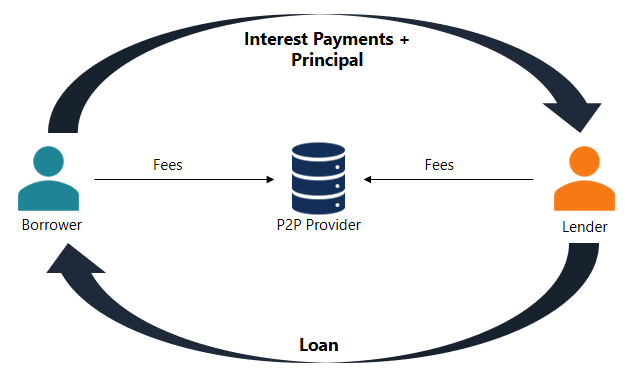Peer-to-Peer Lending
A form of direct money lending to individuals or businesses without an official financial intermediary
What is Peer-to-Peer (P2P) Lending?
Peer-to-peer lending is a form of direct lending of money to individuals or businesses without an official financial institution participating as an intermediary in the deal. P2P lending is generally done through online platforms that match lenders with the potential borrowers.
P2P lending offers both secured and unsecured loans. However, most of the loans in P2P lending are unsecured personal loans. Secured loans are rare for the industry and are usually backed by luxury goods. Due to some unique characteristics, peer-to-peer lending is considered as an alternative source of financing.

How Does Peer-to-Peer Lending Work?
Peer-to-peer lending is a fairly straightforward process. All the transactions are carried out through a specialized online platform. The steps below describe the general P2P lending process:
- A potential borrower interested in obtaining a loan completes an online application on the peer-to-peer lending platform.
- The platform assesses the application and determines the risk and credit rating of the applicant. Then, the applicant is assigned the appropriate interest rate.
- When the application is approved, the applicant receives the available options from the investors based on his credit rating and assigned interest rates.
- The applicant can evaluate the suggested options and choose one of them.
- The applicant is responsible for paying periodic (usually monthly) interest payments and repaying the principal amount at maturity.
The company that maintains the online platform charges a fee for both borrowers and investors for the provided services.
Advantages and Disadvantages of Peer-to-Peer Lending
Peer-to-peer lending provides some significant advantages to both borrowers and lenders:
- Higher returns to the investors: P2P lending generally provides higher returns to the investors relative to other types of investments.
- More accessible source of funding: For some borrowers, peer-to-peer lending is a more accessible source of funding than conventional loans from financial institutions. This may be caused by the low credit rating of the borrower or atypical purpose of the loan.
- Lower interest rates: P2P loans usually come with lower interest rates because of the greater competition between lenders and lower origination fees.
Nevertheless, peer-to-peer lending comes with a few disadvantages:
- Credit risk: Peer-to-peer loans are exposed to high credit risks. Many borrowers who apply for P2P loans possess low credit ratings that do not allow them to obtain a conventional loan from a bank. Therefore, a lender should be aware of the default probability of his/her counterparty.
- No insurance/government protection: The government does not provide insurance or any form of protection to the lenders in case of the borrower’s default.
- Legislation: Some jurisdictions do not allow peer-to-peer lending or require the companies that provide such services to comply with investment regulations. Therefore, peer-to-peer lending may not be available to some borrowers or lenders.
More Resources
CFI offers the Financial Modeling & Valuation Analyst (FMVA)™ certification program for those looking to take their careers to the next level. To learn more about related topics, check out the following free CFI resources: